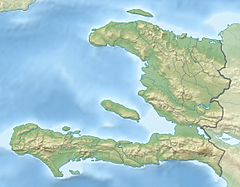Eleutherodactylus lucioi facts for kids
Quick facts for kids Eleutherodactylus lucioi |
|
|---|---|
| Conservation status | |
| Scientific classification | |
| Genus: |
Eleutherodactylus
|
| Species: |
lucioi
|
| Synonyms | |
|
Euhyas lucioi (Schwartz, 1980) |
|
The Eleutherodactylus lucioi is a very rare type of frog. It is also known as the St. Nicholas robber frog. This tiny frog belongs to the Eleutherodactylidae family. It lives only in Haiti, a country in the Caribbean.
Scientists have only ever found one of these frogs. It was discovered near a place called Môle-Saint-Nicolas. This area is in the Nord-Ouest department of Haiti. Because it's so rare, scientists are worried about its future.
Contents
What's in a Name?
How the St. Nicholas Robber Frog Got Its Name
The special name lucioi was given to this frog to honor someone. It remembers John C. Lucio. He was a friend of Albert Schwartz. Albert Schwartz was the scientist who first found this frog. John Lucio helped Albert Schwartz when he was exploring near Port-de-Paix in Haiti.
Meet the St. Nicholas Robber Frog
What Does This Frog Look Like?
The only Eleutherodactylus lucioi ever found was an adult male. It was about 23.6 millimeters long. That's less than an inch, so it's a very small frog!
Its snout, or nose area, is somewhat pointed. The frog has a visible eardrum, called a tympanum. But this eardrum is much smaller than its eye.
Its fingers and toes do not have webbing. Instead, they have small, flat pads called discs. The frog's skin is smooth, or just a little bumpy.
Colors and Patterns
The back of the frog, called the dorsum, is a golden-brown color. It has faint gray patterns. There is also a black or dark gray line near its eye. This line is called a canthal line.
The frog's back legs are a very light pink color. The hidden parts of its body have vague gray patterns. Its belly, or venter, is white.
Where Does It Live?
Home and Challenges for the Robber Frog
The single Eleutherodactylus lucioi was found in a rocky valley. This area had some leftover forest near a river. It was found on a rock sticking out of the stream bank. This spot was about 100 meters above sea level.
The frog was first found in 1979. Sadly, no one has seen it since then. Scientists looked for it again in 1997 in the same place. But they could not find any more.
The biggest danger to this frog is habitat loss. People are cutting down trees and using the land for farming. This destroys the places where the frog might live. Because of this, scientists are not sure if the St. Nicholas robber frog is still alive today. It is listed as critically endangered.



